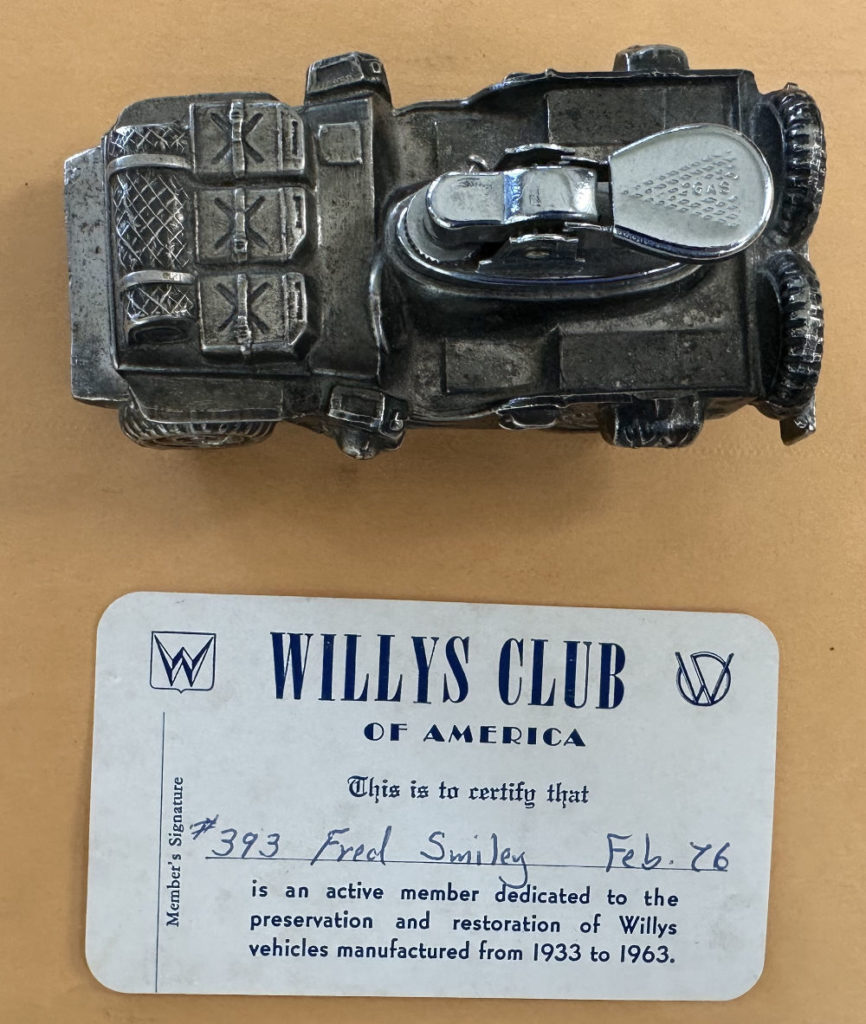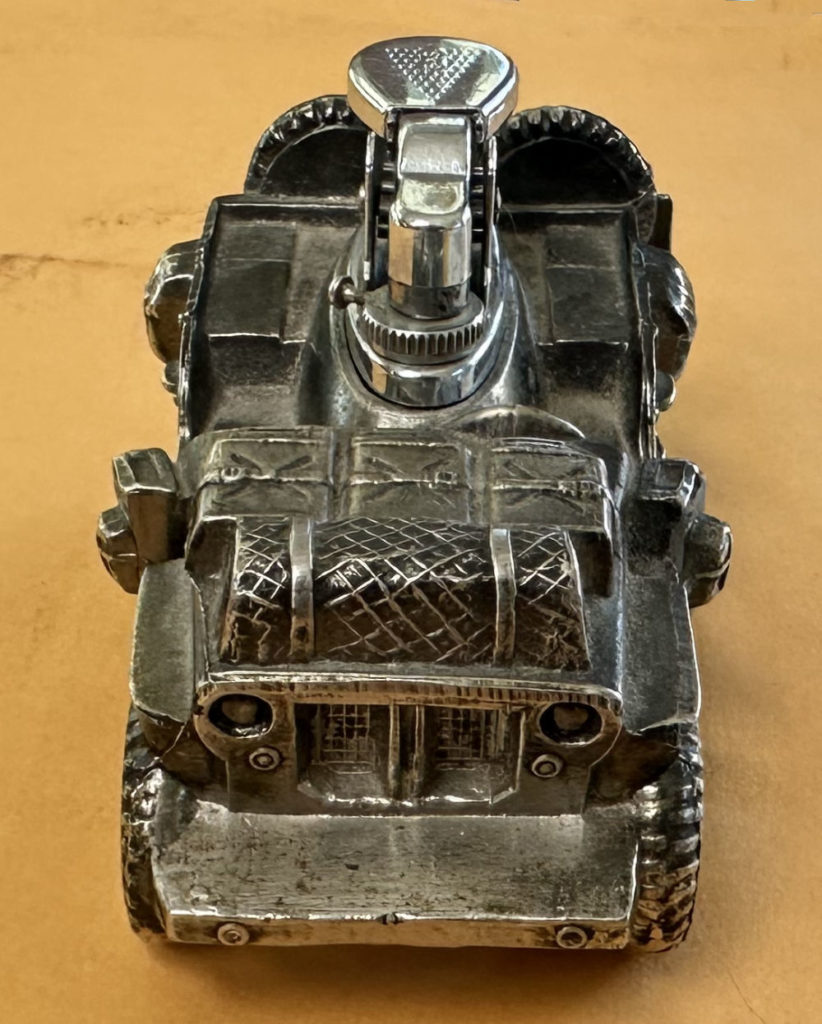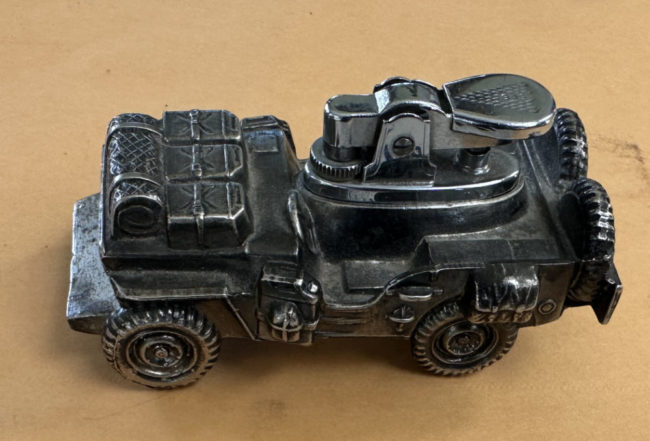This tiny LRDG-styled lighter is something I’d been keeping an eye out for. It’s smaller than I expected, just slightly larger than a biz card (or in this case a Fred Smiley’s old club card, which is something that accompanied a different purchase). I forgot to take a photo of the bottom, but there’s no identifying information there.





The Libyan taxi service!
Not a comment on the item, but on Fred’s card…specifically, the dates of the Willys Club.
Why 1963 as an end date?
I could understand if that was when WO was bought by Kaiser, but that was 1953, not ’63.
Willys cars were discontinued well before that, so that isn’t it either.
John,
1963 was the year Willys Motors became Kaiser Jeep, which meant the brand name of Willys was no longer stamped into the bodies. So, 1963 would be the correct end-year for the club.
David
While looking for something else quite by accident, I just found that out!
I knew you’d have an answer.
Still, it is odd that although they were owned by Kaiser since 1953, the body plates still said Willys or Willys Overland. I know my M38A1 does.
John,
I hope this brief history gives more insight …. I have argued in various posts that Willys-Overland struggled over the years to define what the jeep was. It wasn’t a car, it wasn’t a truck, it was a jeep, a new kind of vehicle, and that struggle can be viewed during W-O’s shifting terminology during WWII, especially after the dispute with Ford that erupted in 1943 over the JEEP trademark (best explained here: http://www.ewillys.com/2019/04/12/345934/ & http://www.ewillys.com/2019/12/25/logos-badges-between-1941-1963/).
After the war, the CJ-2A was introduced not as the “Willys Jeep” but as the “Universal Jeep”. Then came the Jeep Wagon, Jeep Truck and Jeepster models.
By 1948, there was some kind of internal shift in W-O that began to favor using WILLYS as the brand. The ads morphed from emphasizing “JEEP” to emphasizing “WILLYS”, culminating in the Willys Make Sense campaign of 1950 (http://www.ewillys.com/2020/10/31/willys-makes-sense-campaign/). I don’t have internal docs that explain the change, but my guess is the company’s desire to create a car line helped fuel the idea of a non-jeep brand, and given the company had already made cars under the Willys brand before the war, and that some dealers may still have used Willys signage,
the shift back to WILLYS likely made sense.
So, by the time Kaiser bought the Willys-Overland assets in 1953, the marketing of W-O had fully switched to the WILLYS brand. Henry Kaiser wanted to re-emphasize the JEEP brand and 4WD aspects (somewhere I have evidence of this .. he felt Willys was undervaluing both), so by 1954 the new Willys Motors company was publishing brochures highlighting the JEEP brand once again (and to a lesser degree a short-lived Kaiser Willys sub brand). But, Kaiser still had the Willys car line in full production, so how to fully abandon the Willys brand may have been a question that was revisited multiple times over the years, but was made much easier when the Willys car production was finally shut down in 1956. Moreover, dealers continued to have large investments in Willys branding (signs, stationary, etc, etc), so shifting this Willys titanic-sized ship wouldn’t have been easy.
I’d argue Kaiser began executing the move away from Willys by 1958 in little steps, such as changing the dealer marketing flagship newspaper from Willys News to Jeep News (March 1958). I wouldn’t be surprised if Brooks Stevens hard already been approached to design a new 4WD wagon and truck line that could better compete with Detroit’s offerings by that time. I don’t know how long design–>testing–>factory scale up–>marketing scale-up took, but I would think several years at a minimum?
The introduction of the Wagoneer and Gladiator in the summer of 1962 for the 1963 model year, designs so different from any previous Willys, provided the perfect opportunity to finally shed the Willys brand. Two years later all but the CJ-5 & 6 (and a few CJ-3Bs) were all that was left of the older Willys-branded designs.
David
Thanks for the history.
As we see when a firm changes product/marketing direction and ownership, things get murky.